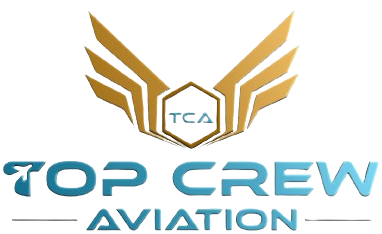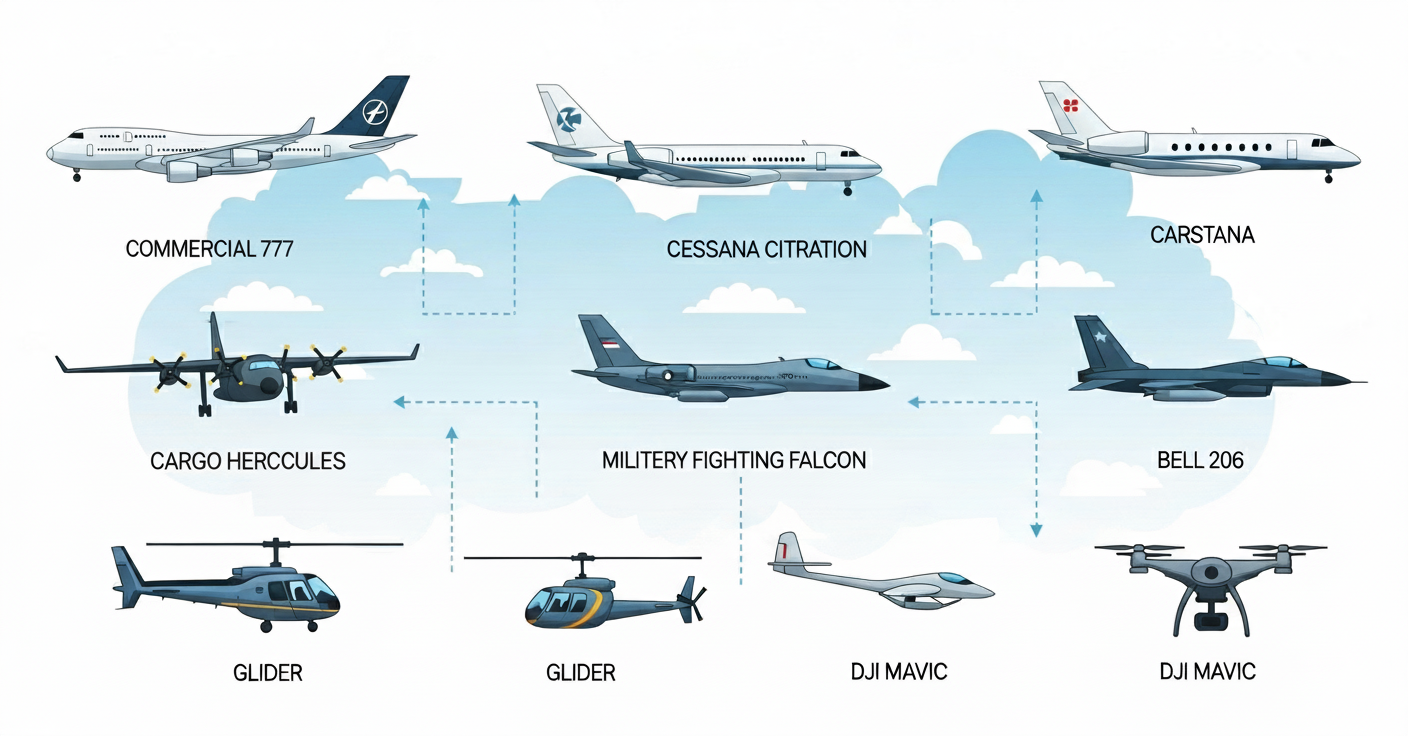When you look up at the sky and see an airplane flying overhead, have you ever wondered what type of aircraft it is? From massive passenger planes that carry hundreds of travelers across continents to sleek fighter jets soaring at incredible speeds, aircrafts come in many shapes and purposes. The aviation industry has designed different aircraft types to meet diverse needs—whether it’s transporting people, delivering goods, defending nations, or simply exploring the skies for pleasure.
Understanding the different types of aircrafts isn’t just fascinating—it’s also useful. If you’re an aspiring pilot, aviation enthusiast, or someone exploring a career in this field, knowing the variety of aircrafts can give you a solid foundation. Each aircraft type has unique features, designs, and roles. Some are built for speed, others for comfort, and some for specialized tasks like firefighting or medical emergencies.
In this blog, we’ll take you through the major categories of aircrafts, from commercial airliners and private jets to helicopters, military aircraft, cargo planes, and even drones. We’ll simplify everything into easy-to-read sections with tables, comparisons, and real-world examples so you can quickly grasp the essentials.
By the end, you’ll have a clear picture of how each type of aircraft plays a role in aviation and daily life. So, let’s dive in and explore the skies together!
1. Commercial Aircrafts: Carrying the World
Commercial aircrafts are the most common and recognizable. These are the planes we use for air travel, connecting cities, countries, and continents.
Key Features
- Designed for passenger comfort and safety.
- Range varies from short-haul regional jets to long-haul wide-body aircrafts.
- Operated by airlines such as IndiGo, Emirates, and Singapore Airlines.
Common Types
- Narrow-body Aircrafts
- Example: Airbus A320, Boeing 737
- Carry around 150–200 passengers
- Used for domestic and short international routes
- Wide-body Aircrafts
- Example: Boeing 777, Airbus A350
- Carry 250–400+ passengers
- Ideal for long-haul international flights
- Regional Aircrafts
- Example: ATR 72, Embraer E-Jets
- Carry 50–100 passengers
- Used for short regional routes
Comparison Table
| Aircraft Type | Passenger Capacity | Flight Range | Example Models |
| Narrow-body | 150–200 | Short–Medium haul | Airbus A320, B737 |
| Wide-body | 250–400+ | Long haul | Boeing 777, A350 |
| Regional Jets | 50–100 | Short haul | ATR 72, Embraer E190 |
Commercial aircrafts are the backbone of aviation, enabling global connectivity, tourism, and trade.
2. Private Jets: Luxury in the Sky
Private jets symbolize exclusivity and convenience. Unlike commercial aircrafts, they are designed for individuals, corporations, or VIPs who value privacy, speed, and luxury.
Why People Use Private Jets
- Avoids long airport lines.
- Flexible scheduling—fly on your own time.
- Access to smaller airports closer to destinations.
Types of Private Jets
- Light Jets
- Carry 4–8 passengers
- Short to mid-range flights
- Example: Cessna Citation CJ3
- Midsize Jets
- Carry 8–10 passengers
- Offer more space and range
- Example: Learjet 60
- Heavy Jets
- Carry 12–18 passengers
- Long international flights with luxury interiors
- Example: Gulfstream G650, Bombardier Global 7500
Quick Comparison
| Category | Passenger Capacity | Flight Range | Comfort Level |
| Light Jets | 4–8 | 1,500–2,500 km | Basic luxury |
| Midsize | 8–10 | 3,000–5,000 km | High comfort |
| Heavy Jets | 12–18 | 10,000+ km | Ultra-luxury |
Private jets are not just for billionaires. Today, jet-sharing programs and charter services make them more accessible. They’re popular for business travel, celebrities, and even urgent medical flights.
Read Also – Do You Need a Degree to Become a Commercial Pilot?
3. Cargo Aircrafts: Delivering Goods Worldwide
While commercial aircrafts carry people, cargo aircrafts are built to transport goods. They keep the global supply chain running smoothly.
Key Features
- Large cargo doors for loading/unloading.
- Designed to carry heavy or oversized loads.
- Operated by companies like FedEx, DHL, UPS.
Types of Cargo Aircrafts
- Dedicated Cargo Aircrafts
- Example: Boeing 747-8F, Antonov An-124
- Built specifically for freight
- Can carry oversized cargo like vehicles
- Converted Passenger Aircrafts
- Retired passenger planes modified for cargo
- Cheaper alternative for airlines
- Military Cargo Planes
- Example: Lockheed C-130 Hercules
- Used for military supplies, disaster relief, and humanitarian aid
Interesting Example
The Antonov An-225 Mriya was the largest aircraft ever built, designed to transport massive payloads.
Benefits of Cargo Aircrafts
- Enables fast international shipping.
- Critical for e-commerce and express delivery.
- Supports global trade and relief operations.
Cargo aircrafts are the unsung heroes of aviation, ensuring that goods—from smartphones to medicines—reach their destinations quickly and safely.
4. Military Aircrafts: Power and Defense (250–300 words)
Military aircrafts are designed for national defense, combat, and specialized missions. They showcase advanced technology and engineering.
Categories
- Fighter Jets
- Example: F-16 Fighting Falcon, Dassault Rafale
- Built for speed, agility, and combat
- Bombers
- Example: B-2 Spirit, B-52 Stratofortress
- Carry heavy weapons and bombs
- Transport Aircrafts
- Example: C-17 Globemaster III
- Move troops, vehicles, and supplies
- Reconnaissance and Surveillance Aircrafts
- Example: AWACS, U-2
- Used for intelligence and monitoring
Features of Military Aircrafts
- Stealth technology for undetectable missions.
- High speed and maneuverability in combat.
- Equipped with advanced radars and weapons systems.
Military aircrafts are critical for protecting nations, responding to emergencies, and conducting peacekeeping missions. They also influence civilian technology—many innovations like GPS originated from military aviation.
5. Helicopters: Versatile and Unique
Helicopters are among the most versatile aircrafts, capable of vertical take-off and landing. Unlike airplanes, they don’t need long runways.
Uses of Helicopters
- Medical emergencies (air ambulances).
- Search and rescue missions.
- Military operations.
- Tourism and aerial photography.
- Offshore oil rig transportation.
Types of Helicopters
- Light Helicopters
- Example: Robinson R44
- Used for training and personal use
- Utility Helicopters
- Example: Bell 412
- Used for transport, law enforcement, and firefighting
- Heavy-Lift Helicopters
- Example: Sikorsky CH-53K
- Carry large cargo loads and troops
Advantages
- Can access remote and rugged areas.
- Ideal for emergency response.
- Provide aerial views for filming and tourism.
Helicopters are truly lifesavers, proving their worth in disaster relief, medical evacuations, and missions where airplanes cannot operate.
6. Drones: The Future of Aviation
Drones, or Unmanned Aerial Vehicles (UAVs), are the newest entrants in the aviation world. They’re remotely piloted or autonomous.
Uses of Drones
- Aerial photography and videography.
- Military surveillance and combat.
- Agriculture—crop monitoring and spraying.
- Package deliveries (Amazon Prime Air).
- Disaster response and rescue missions.
Categories
- Consumer Drones
- Example: DJI Phantom
- Used by hobbyists and photographers
- Commercial Drones
- Example: Zipline delivery drones
- Used for logistics, inspections, and mapping
- Military Drones
- Example: MQ-9 Reaper
- Surveillance and targeted operations
Benefits
- Cost-effective compared to manned aircrafts.
- Can reach dangerous or inaccessible areas.
- Growing role in industries like healthcare and logistics.
Drones represent the future of aviation, merging technology with accessibility. As regulations evolve, drones are expected to revolutionize transportation and service industries.
Conclusion
From massive commercial airliners carrying thousands of travelers daily to nimble drones reshaping modern industries, the world of aircrafts is diverse, innovative, and vital. Each type—whether it’s passenger planes, private jets, cargo freighters, military machines, helicopters, or drones—has a unique role to play. Together, they form the backbone of global connectivity, trade, defense, and exploration.
Understanding the different types of aircrafts not only broadens your knowledge but also helps if you’re considering a career in aviation. For aspiring pilots, cabin crew, or aviation professionals, this knowledge builds a strong foundation for training and career growth.
At Top Crew Aviation Institute, we specialize in shaping the future of aviation professionals. Whether you dream of flying commercial aircrafts, serving as cabin crew, or exploring aviation management, our expert training and world-class facilities will help you achieve your goals.
If you’re ready to turn your passion for aviation into a rewarding career, take the first step today with Top Crew Aviation. The sky isn’t the limit—it’s just the beginning.
FAQs
Q1. What are the main types of aircrafts?
Commercial aircrafts, private jets, cargo planes, military aircrafts, helicopters, and drones are the main categories.
Q2. What is the difference between narrow-body and wide-body aircrafts?
Narrow-body aircrafts have a single aisle and fewer seats, while wide-body aircrafts have two aisles and carry more passengers over long distances.
Q3. Can helicopters fly long distances?
Helicopters are best for short to medium distances. Their range is usually limited compared to airplanes.
Q4. Are drones considered aircrafts?
Yes, drones or UAVs are classified as aircrafts since they operate in the air, even though they are unmanned.
Q5. Which is the largest aircraft in the world?
The Antonov An-225 Mriya was the largest aircraft ever built, capable of carrying massive loads.
Q6. What are cargo aircrafts used for?
They transport goods, machinery, and supplies across the globe, supporting trade and humanitarian missions.
Q7. Do private jets need special airports?
Not always. Private jets often use smaller regional airports, giving them more flexibility.
Q8. What are fighter jets designed for?
Fighter jets are built for speed, agility, and combat missions to protect airspace and engage in warfare.
Q9. How are drones changing aviation?
Drones are revolutionizing industries with aerial photography, delivery services, agriculture, and even medical supply transport.
Q10. What is the future of aircraft technology?
Electric planes, autonomous drones, and eco-friendly designs are expected to shape the future of aviation.


